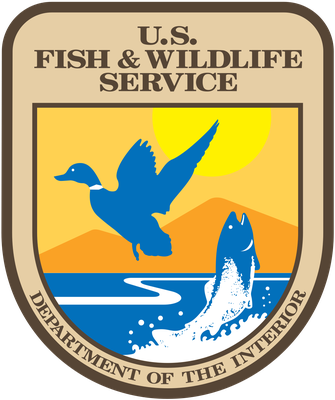Prairie Reconstruction Guidebook for North Dakota (R1840, July 2017)
Availability: Web only
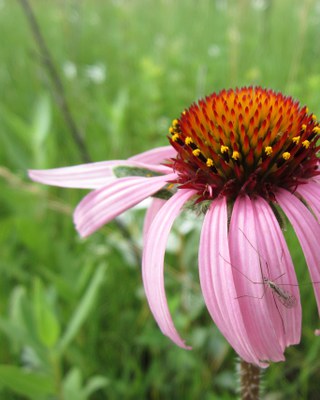
photo by Cami Dixon, USFWS
This guidebook will focus on prairie reconstruction, defined as the planting of a native seed mixture composed of multiple prairie species (graminoids, forbs and small shrubs) in an area where the land has been cultivated or anthropogenically disturbed. This definition differs from prairie restoration, which focuses on utilizing treatments, such as prescribed burning and grazing, to increase the biodiversity of native plant populations within native prairie, or land areas with no cultivation history.
Reconstructing prairies on former cultivated areas provides opportunities to create sustainable and resilient grassland cover that reduces soil erosion and invasive species while creating habitat for a variety of native wildlife. In addition, with proper planning, a reconstruction can initiate the re-establishment of site ecological processes. Grassland ecological processes include the:
- water cycle (capture, storage and redistribution of precipitation)
- energy flow (conversion of sunlight to plant and animal matter)
- nutrient cycle (cycling of nutrients such as nitrogen and phosphorous through the physical and biotic components of the environment) (Pellant et al. 2005)
When ecological processes function within a normal range, they support grassland integrity. These processes are ecosystem drivers, providing a variety of feedback mechanisms to shift the vegetative state (Pellant et al. 2005). Thus, landowners have important considerations when planning prairie reconstructions. When these reconstructions are in place, they can improve an ecosystem’s resistance and resilience.
Resistance and resilience measures can provide insight into the overall health before and after reconstructions. Resistance is the ability of ecological processes to function with minimal input following a disturbance. Resilience is the rate of recovery and/or extent of recovery during a specific period. Resistance and resilience provide a way of describing grassland’s ability to remain within the environmental normal range.
However, resistance and resilience in a prairie reconstruction vary based on the current vegetative state. Therefore, vegetation composition, or production, are metrics used as substitutes (Pellant et al. 2005). In the end, reconstructions are complex systems in which ecological processes are difficult to measure. For this reason, developing a comprehensive seeding and monitoring plan for each reconstruction is important.
The purpose of this document is to provide prairie reconstruction guidance for land managers in North Dakota and surrounding areas. Described methodologies will allow for the proper planning, implementation and establishment of prairie reconstructions based on articulated goals.
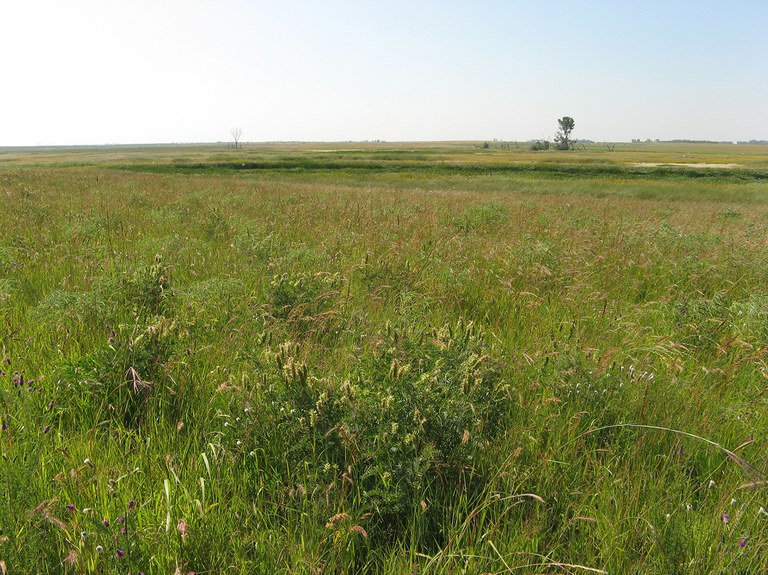
Completed prairie reconstruction site.
(Cami Dixon, USFWS)
Preparing for Prairie Reconstruction
Preparing for a prairie reconstruction is a multiphase process, which is dictated by the scope and scale of the historic land use, current plant community and land manager’s goals. Table 1.0 outlines the phases of reconstruction, and associated steps and descriptions to achieve success. Careful consideration of each step, in terms of the reconstruction goals, creates the strongest opportunities for success.
|
Table 1.0. The phases of prairie reconstruction, along with associated steps and descriptions, are provided in a summarized format. Further details are provided in the accompanying text. |
||
|
Phase |
Steps (1-6) |
Description |
|
Planning |
Goals and Objectives Site Selection |
The planning phase involves developing goals and objectives, and selecting the reconstruction site. This information drives the implementation and establishment phases. |
|
Implementation |
Site Preparation Seeding |
The implementation phase incorporates methodologies for site preparation and describes the numerous aspects to consider when implementing a seeding. |
|
Establishment |
Management Actions Evaluation |
The establishment phase incorporates the management actions and evaluation measures critical for determining goal and objective achievement. |
Planning Phase
The planning phase should start with developing goals for the prairie reconstruction, creating objectives, and articulating planned management strategies and methods for evaluation. Decisions for selecting a reconstruction site are intertwined in this phase.
Step 1 – Setting Goals and Determining Objectives
Developing plans for prairie reconstruction involves creating “clear and unambiguous” goals and objectives (Laubhan et al. 2012). Goals are a general description, or guideline of optimal post-reconstruction conditions (Laubhan et al. 2012). To determine if goals where achieved, the project relies on objectives and strategies.
Objectives articulate clear and measureable short-term targets reached by a specific time (Laubhan et al. 2012). Strategies are actions used to achieve the objectives, while an evaluation measures objective achievement. Figure 1.0 defines goals, objectives and strategies, while Figure 2.0 provides example goals, objectives and strategies highlighting time frames and measures.
Considering the vast changes that prairie landscapes have incurred since European settlement, prairie reconstruction goals, objectives and strategies should focus on the desired results for a specific site, rather than restoring it to historic integrity.
Figure 1.0 depicts the hierarchical relationship and definitions among the four levels in planning for a reconstruction. Starting with the “goals,” which form the highest and foundational level of the pyramid, the diagram follows a natural progression in focus and specificity down to the lower levels. Following the planning process outlined in these four levels provides for improved reconstruction successes.
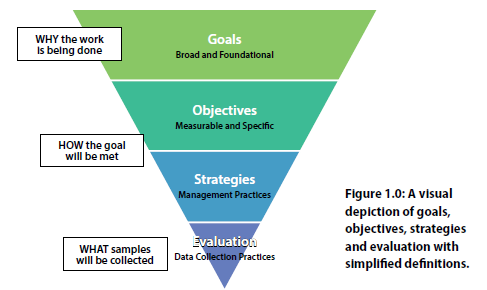
The planning phase includes developing explicate goals, objectives, strategies and evaluation methods. This example (Figure 2.0) of the planning process is site-specific (for example, dependent upon factors such as local climate and soil types), so not all plans will include the details noted in this figure. Information provided throughout this guidebook may assist land managers in developing site-specific goals, objectives, strategies and evaluations.
Evaluation varies from objective to objective, depending on the goal for reconstruction. For this reason, considering what information will be beneficial to the specific reconstruction is important when developing a management and evaluation plan. Table 2.0 provides examples from the recommended three-tier evaluation approach of the example objectives provided in Figure 2.0.
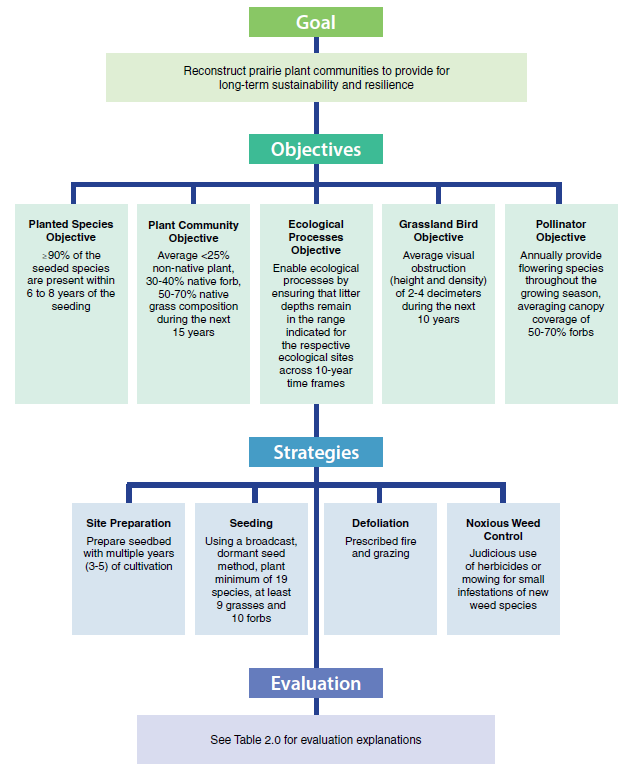
Figure 2.0: Examples of a goal, objectives, strategies and evaluation methods.
|
Table 2.0: Example objectives with potential evaluation methods using the three-tier approach. |
|
|
Objective |
Tier and Example Methodology |
|
Planted Species |
Tier 1 |
|
Plant Community |
Tier 2 |
|
Ecological Processes |
Tier 2 |
|
Grassland Bird |
Tier 2 |
|
Pollinator |
Tier 3 |
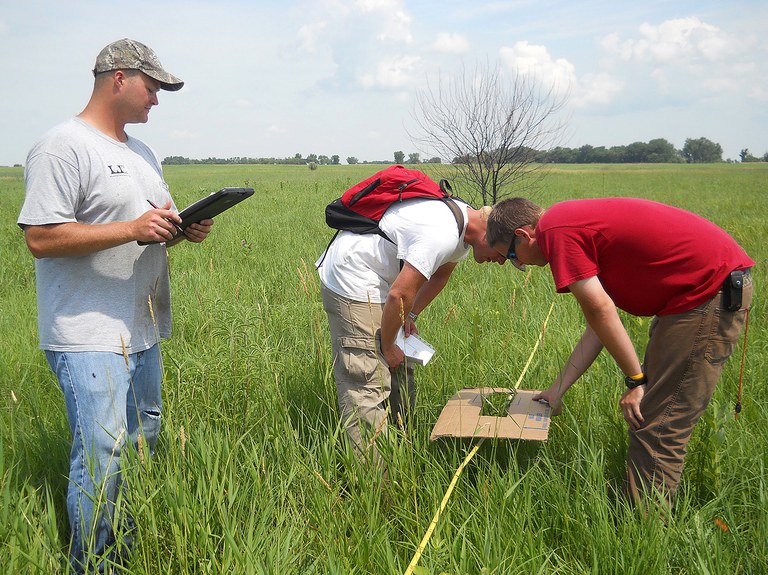
Evaluating a prairie reconstruction.
(Sara Vacek, USFWS)
Step 2 – Site Selection
Understanding the limitations or the reconstruction potential of a particular site can facilitate reasonable goal development and appropriate objectives and strategies. An optimal reconstruction target site contains an area of land with specific physical characteristics that enable it to produce a specific native plant community (Sedivec and Printz 2012, Wark et al. undated).
Webpage hyperlinks for the 2016 ecological site descriptions and morphological summary tables are in the reference list (See Appendix A). These tables identify potential climax plant communities for any given site based on hydrogeomorphic factors. Sedivec and Printz (2012) provide guidelines for determining stable, transitional, degraded and climax plant communities for many soil types found in mixed and tallgrass prairie sites in North Dakota.
Site-specific potential also can be determined using numerous tools to direct prioritization. Species distribution and spatial models are two potential tools. Species distribution models can be developed to determine the suitability of a site for certain weeds (for example, yellow toadflax, leafy spurge; Crall et al. 2013, Uden et al. 2015).
For example, if an area planned for reconstruction is vulnerable to leafy spurge invasion, land managers may want to reconsider or adjust the seed mix to provide more competition.
Spatial models for wildlife also may be useful in determining and prioritizing sites for reconstruction. Reynolds et al. (2006) and Niemuth et al. (2008) describe descriptions of model development and associated examples for waterbirds. Johnson et al. (2010) describe the background behind the grassland bird conservation areas, providing associated figures to help identify sites that may be priority for reconstruction across the Prairie Pothole Region based on predicted bird occurrences.
Implementation Phase
The implementation phase incorporates methods for site preparation and seeding. Several options exist for seedbed preparation, depending on the individual site characteristics. Seeding methods include factors such as timing, selecting species and seed sources.
Step 3 – Site Preparation
Seedbed Preparation
The goal of site preparation is to increase the likelihood of native seed establishment. This process involves excessive litter removal to improve seed-to-soil contact and reduce weeds by promoting native species’ growth (Smith et al. 2010). Preparation activities should be organized prior to seeding and followed throughout the reconstruction period. Shortcuts can lead to establishment failures (Schramm 1990, Wark et al. undated).
Inadequate weed control, especially of cool-season invasive grasses, causes more grass seeding failures than any other factor (Duebbert et al. 1981, Jordan 1988, Roundy and Call 1988, Wilson and Gerry 1995). These species readily re-sprout from persistent seedbanks or remnant root and vegetative fragments.
Potential methods for site preparation are described in this section and presume the site possesses a history of cultivation. A summary of these methods is provided in Table 3.0.
Table 3.0. Overview of seedbed preparation methods.
Methods for seedbed preparation are listed based on the associated site conditions, limitations, time commitments and actions required. More details about each method are provided in the accompanying text.
|
Method |
Site Conditions |
Limitation |
Time Commitment |
Action(s) Required |
|
Clean-till |
Areas with previous cropping history or other formerly cropped sites currently covered with perennial invasive plants (for example, smooth brome, Kentucky bluegrass) |
May require three to five years of cropping for seedbed preparation |
Three to five years or possibly less if site has been in cropping rotation prior to reconstruction decision |
Tillage, herbicide, crop production |
|
No-till |
Areas with previous cropping history that have been in a conservation tillage system |
May require three to five years of cropping for seedbed preparation Extra straw or chaff needs to be removed prior to seeding Concerns with seed-to-soil contact |
Three to five years or possibly less if site has been in cropping rotation prior to reconstruction decision |
Straw or chaff removal with harvest equipment, herbicide and crop production |
|
Tillage and Herbicide Summer Fallow |
Areas with previous cropping history or other disturbed sites in current cover of perennial invasive plants (for example, smooth brome, Kentucky bluegrass) |
Process is labor-, fossil fuel- and time-intensive |
Four years |
Tillage, herbicide |
|
Stand Enhancement |
Areas with established grass stands |
Competition from current stand of grasses may limit opportunities for success |
One to three years or longer |
Possible actions: burning, mowing, grazing, herbicide |
|
Cover Crop |
Areas with previous cropping history or other disturbed sites in current cover of perennial invasive plants (for example, smooth brome, Kentucky bluegrass) |
More research needed; benefits and limitations not clearly understood
|
One to three years |
Tillage, herbicide, planting |
The Clean-till Method
The clean-till method is best suited for disturbed areas primarily composed of perennial invasive plants (for example, smooth brome [Bromis intermis] and Kentucky bluegrass [Poa pratensis]). A nonselective herbicide application treatment is applied to the existing vegetation, followed by plowing or tillage, exposing roots to harsh winter conditions (Schramm 1990).
Establishing an annual crop prior to seeding the site can serve as a pre-seeding weed control. Annual cropping allows for repetitive herbicide and tillage applications. If the site has a high density of perennial invasive plants, land managers often complete a three- to five-year cropping rotation (clean-till method) to prepare the land for a cleaner seedbed.
Land managers using herbicides as part of this preparation method will need to consider residual effects, which can inhibit the growth of some native grasses and forbs for up to four years following application (Smith et al. 2010). For example, an Aminopyralid, such as Milestone, can have residual effects for three to four years.
This method is the preferred option for seedbed preparation in North Dakota and surrounding areas when reconstructing sites dominated by cool-season invasive grasses. Soil erosion and short-term impacts to soil structure and organic matter are the major drawbacks of this method. Soil attributes will recover when the native perennial cover is established.
No-till Method
The no-till method allows for seeding, without tillage, into standing stubble of a previous crop (USDA 2015). This method occurs under a conservation tillage or no-tillage cropping system. Excess straw or chaff should be removed prior to seeding; however, a light layer of residue may be desirable.
To prevent excess chaff problems, use harvest equipment that spreads straw along a minimum of 80 percent of the header width (USDA 2015). If invasive species are present or the previous crop has excessive regrowth, herbicides may be needed (Schramm 1990, USDA 2015).
Tillage and Herbicide Summer Fallow (Chemical Fallow) Method
The tillage and herbicide summer fallow method is labor- and fossil fuel-intensive, but may provide a proper seedbed for prairie reconstructions. For sites with persistent perennial weeds, Wark et al. (undated) recommends herbicide treatments combined with tillage.
Tillage equipment used should have minimum surface erosion potential. The bare soil conditions created by this preparation method are suitable for broadcast or drill seeding. Again, the land manager will need to consider herbicide residual effects.
An example seedbed preparation schedule using an annual cropping method:
- Year 1 – Disk the site two to three times.
- Year 2 – Treat with glyphosate (spring) and disk two to three more times.
- Year 3 – Treat with glyphosate (spring) and disk two to three more times.
- Year 4 – Treat with glyphosate (spring) and then wait at least 14 days (or as label instructs) after herbicide application to plant a native seed mixture.
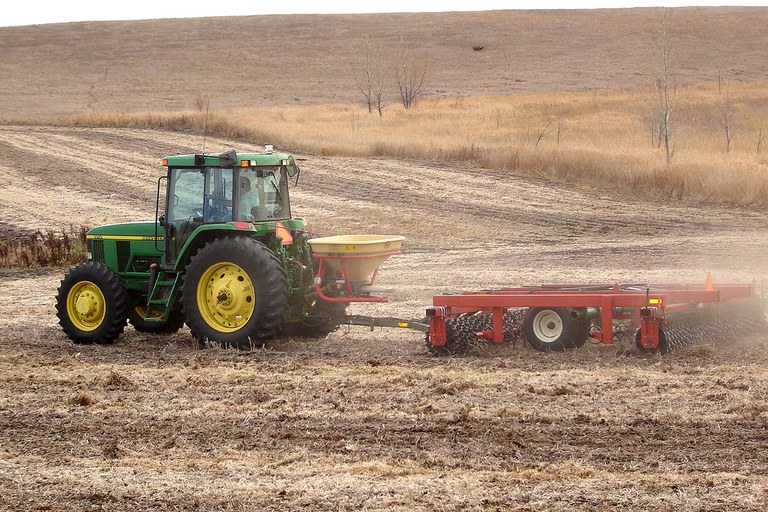
Preparing the seedbed with a cultipacker.
(Kyle Kelsey, USFWS)
Stand Enhancement (Interseeding)
Seed additions into an established stand of vegetation without disrupting the soil is called stand enhancement or interseeding. Established stands may range from monotypes of warm-season native grasses to cool-season invasive grasses.
Enhancement commonly involves increasing heterogeneity through native forb and native grass inclusion without totally removing the established stand (Smith et al. 2010). Site preparation includes multiple years of consecutive burning, mowing, grazing and possible herbicide treatments to increase opportunities for seed-to-soil contact and reduced competition (Packard and Mutel 1997; Smith et al. 2010).
Stand enhancement as a seeding method results in mixed successes (Martin and Wilsey 2006, Foster et al. 2007, Martin and Wilsey 2014). Cool-season invasive grasses such as smooth brome and Kentucky bluegrass may increase with site preparation activities (for example, burning) (Packard and Mutel 1997), creating a more competitive environment for newly seeded species.
If the current plant community includes smooth brome, the soil likely has been modified to facilitate the growth of this plant and may be less compatible for native plant growth (Jordan et al. 2008). When Kentucky bluegrass dominates a site, a thatch layer occurs and may limit seed-to-soil contact despite prior burning and herbicide treatment.
The challenges associated with stand enhancement limit the opportunities for success when utilizing this preparation method. If increasing forb diversity is desired, Grygiel et al. (2009) provide a method for creating small disturbances within established stands utilizing a technique that requires cultivating and seeding small patches.
Cover Crop Method
The cover crop method involves planting a high residue-producing crop, such as oats, barley, flax, grain sorghum or millet. The cover crop is seeded during the growing season before or during seeding of the reconstruction plants. This method is most effective when the existing cover is insufficient to control erosion. Other objectives such as weed suppression and increased fuels for fire do not appear to occur with cover crop use (Helzer et al. 2010).
Research still is lacking in the area of tuber (radishes, turnips, etc.) cover crops. Current literature should be reviewed and discussions with experienced personnel should occur prior to utilizing cover crops.
Nutrients
Prior to European settlement, the prairie was a nitrogen-limited system, but anthropogenic activities have changed nutrient processes (Funk and Vitousek 2007). Overnitrification of soils is often a concern that needs to be addressed in the site preparation process. Soil nutrient levels can increase due to fertilization of soils and the varying nutrient cycles of non-native plants.
Several studies have shown correlation between increased nutrients and invasion of exotic plants; therefore, controlling nitrogen (N) and phosphorus (P) availability on cultivated lands prior to implementing reconstruction can reduce the likelihood of invasion (Funk and Vitousek 2007, Rowe 2008). For example, shoot production of established Canada thistle is correlated positively with N availability in soils (Hamdoun 1970). The likelihood of high nutrient levels is increased in cultivated areas that have been treated continuously with fertilization (McLauchlan 2006).
Vasquez et al. (2008) developed a conceptual model that predicts the outcome of community dynamics based on N availability and demonstrates the relationship between invasion by non-native plants and soil nutrients. This model predicts that at some increased level of N, early seral species and invasive annual grasses are able to grow and reproduce more successfully than native mid- and late-seral species (Vasquez et al. 2008). Similarly, at some point, an increase in phosphorus will promote early seral and invasive species rather than native late-seral species (Grygiel et al. 2010).
Certain native plants (for example, sunflower) uptake nutrients better than others and could be added to a seed mixture for sites when nutrient levels are a concern (see Levang-Brilz and Biondini 2002). Annual crops that utilize high nutrients (for example, corn and sunflowers) are another way to remediate high nutrient levels in soils. For more details on selecting species to seed, see Step 4-Seeding.
To best understand site preparation needs, practitioners should collect soil samples and test for nutrient content. Companies can provide analysis of phosphorous, nitrogen and other constituents of soil samples. This kind of documentation will help direct the planning process for seeding. For example, if phosphorus levels are high enough to support a corn crop, the site is likely too nutrient-rich to promote native plants instead of weedy plants.
Herbicide Residue
In general, controlling invasive species should be performed in the years preceding seeding as well as shortly before seeding installation (Wark et al. undated). Depending on the herbicide used, application can occur between six days (Schramm 1990) and three weeks prior to seeding (Wark et al. undated), although waiting too long may allow weed seeds to start germinating, giving them the competitive advantage over newly seeded plants.
The exact timing and application depends largely upon the target weeds controlled, site conditions and longevity of herbicide carryover. For example, Wark et al. (undated) recommend applying glyphosate from mid-August to early September when controlling Canada thistle and quackgrass to ensure plants are green and actively growing.
Herbicide application history is an important factor to consider in site preparation. Herbicide residue can inhibit establishment of some native grasses and forbs for up to four years after application (Smith et al. 2010). For this reason, the previous four years’ herbicide history should be reviewed prior to seeding.
Residues from certain herbicides, such as Milestone and Odyssey, may prevent the establishment of some native plants, specifically forbs. If herbicide use is suspected on a site, delaying seeding eliminates potential carryover of residual herbicide.
Firm Seedbed
The final step in preparing the site is creating a firm seedbed, which ensures the seed is placed at the appropriate depth. The soil should be firm enough that adult footprints are hardly visible when walking across the packed soil (USDA 2015, Packard and Mutel 1997). Often, seedbed preparation activities produce a firm seedbed; however, if this does not occur, a standard agricultural cultipacker can be used to pack the soil.
Step 4 – Seeding
Methods
Planting seeds at the proper depth and facilitating good seed-to-soil contact are key factors in a successful prairie reconstruction. Optimum depths for native grasses, forbs and small shrubs are ¼ to ¾ inch (USDA 2015, Smith et al. 2010). Seeds planted too deeply in the soil will not germinate due to the inability of light to penetrate. Two main seeding methods are used in reconstructions: grass drilling and broadcast seeding.
Grass Drill
A grass drill is well suited for seeding into an existing stand or firmly packed bare seedbed, or following an annual crop (Smith et al. 2010). The seed must be cleaned, prepared, mixed, calibrated and debearded. The drill operator must operate the drill properly for a successful seeding.
Monitoring seeding depth is important to assure a continually shallow (¼ to ¾ inch) distribution occurs because seed planted too deeply will not emerge. Forb seeds must be seeded at a very shallow depth to promote emergence.
Grass drills usually can handle three types of seed with the differing seed boxes.
The types of seed are:
- clean, smooth seeds (for example, western wheatgrass, slender wheatgrass)
- fluffy seeds (for example, little bluestem, porcupine grass)
- fine, smooth seed (for example switch grass, Canada milkvetch) (USDA 2015)
For details on which boxes are best for individual species, see Smith et al. (2010), Table 5.2. In addition, USDA (2015) provides documentation on drill calibration; however, we recommend that land managers inexperienced in grass drilling seek assistance from professionals experienced in calibrating and operating a drill.
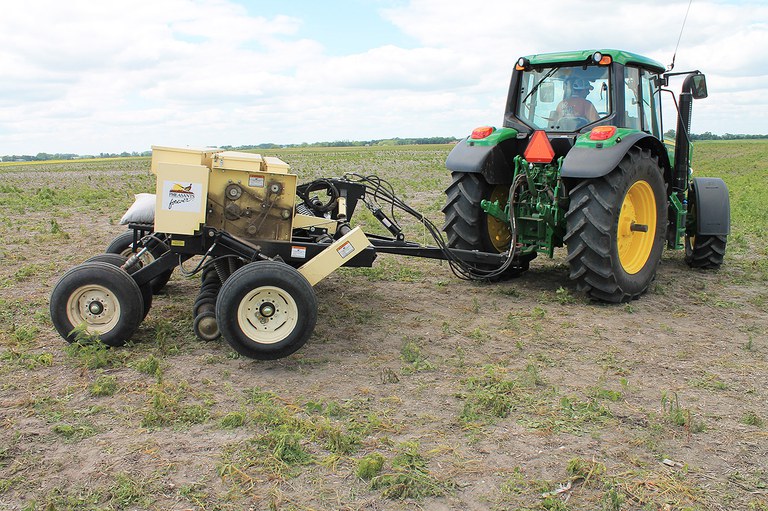
Grass drill and tractor.
(J.B. Bright, USFWS)
Broadcast Seeding
Broadcast seeding requires a smooth, firmly packed seedbed with minimal residual cover. The different seed species need to be mixed properly and seeding rate carefully calculated. Unless utilizing the snow/frost seeding method , we recommend that a drag harrow, cultipacker, roller packer or similar equipment be pulled behind the broadcaster to press the seed into the soil surface to maximize seed-to-soil contact (USDA 2015).
If you are using seeding rate calculations from USDA (2015), we recommend you increase this rate by 1.5 times (USDA 2015). Smith et al. (2010) reported that for snow/frost broadcast seeding, increase the rate by 25 percent from the regular seeding rates. Increasing seeding rates compensates for losses from wind erosion, predation and seeds distributed too deeply (Smith, et al. 2010).
If selecting the broadcast method, reconstructionist prefer seeding into soybean stubble rather than corn because corn residue leaves furrows that may impede broadcasted seed from making seed-to-soil contact (Rowe 2008, Helzer et al. 2010). In comparison, soybeans create a light layer of residue that can help bind seeds (Rowe 2008). However, several successful seedings have occurred in corn stubble when stocks are lying down and the soil packed appropriately.
Deciding whether to broadcast or drill depends on the seeding objective and site-specific factors. For example, broadcasting appears to be the preferred method when seeding a high-diversity mixture (including warm- and cool-season plants) on a site with adequate moisture (Norland et al. 2015, Helzer et al. 2010); conversely drilling may be preferred for a warm-season grass-dominated mixture seeded in the spring (Rowe 2010). Initial establishment (Bakker et al. 2003, Rowe 2010), along with plant community composition and productivity after several years (Newman and Redente 2001), is similar between the two methods.
Despite similarities in production and composition, the two methods do have their own advantages and disadvantages. Drilled seeds tend to be more buffered from drying than those broadcasted onto the soil surface. In Saskatchewan, germination was higher for grass seeds buried one centimeter deep than for those scattered on the soil surface (Ambrose and Wilson 2003). The opposite result occurred at another site nearly 80 miles away, where broadcasting was more effective (Bakker et al. 1997).
Norland et al. (2015) identified that planting a seed mix with high grass and forb diversity in conjunction with broadcast seeding produced the most successful results. Drilling promotes grass germination (Yurkonis et al. 2010, Larson et al. 2011) and appears to have a potential negative effect on forb diversity (Grygiel et al. 2009, Larson et al. 2011, Norland et al. 2015).
The variability of these findings emphasize the necessity of basing a reconstruction on site conditions (soils and weather), timing, history and existing vegetative cover.
No matter which approach is used, the seedbed should be prepared so that it is free of competing vegetation, firmly packed, not subject to excessive erosion and in a location unaffected by herbicide residues or excessive nutrients. Table 4.0 provides a simplified overview of the two different seeding methods.
|
Table 4.0: Overview of Seeding Methods. |
||||
|
Method |
Soil Requirements |
Tools Required |
Pros |
Cons |
|
Grass Drill |
A firmly packed bare seedbed or established stand |
Grass drill |
Increases grass germination Decreased seed |
Seeds may be drilled at inappropriate depths Drill may not distribute fluffy seeds efficiently if not prepared properly May decrease forb diversity Calibration can be challenging |
|
Broadcast |
Smooth, firmly packed seedbed with minimal residual cover |
Broadcaster or hand dispersal Drag harrow, cultipacker, |
Preferred by many reconstructionists Increased forb diversity |
Increased seed dry-out Increased seed percentages recommended to account for exposure to weather conditions, predation and seed depth error |
Timing
The time of year that a planting occurs is another critical factor to consider in the seeding step. The following options exist for the time of year a planting may occur in North Dakota: dormant, spring, summer and snow or frost. Detailed information on the timing options is provided in the text, while an overview of each method is provided in Table 5.
|
Table 5.0: Overview of timing. |
|||
|
Timing |
Temperature/Time Requirements |
Advantages |
Disadvantages |
|
Dormant |
Soil must be 40° F for minimum of five days |
Mimics natural cycle Forbs respond well |
Seed mixes with higher grass ratios may not respond as well |
|
Spring |
April-June depending |
Favors cool-season species with early spring seeding Favors warm-season grasses if seeded in mid to late spring |
Forbs requiring stratification may not germinate initially |
|
Summer |
Mid to late summer |
Species that germinate quickly may thrive |
Does not provide enough time between germination and winter Increased likelihood for drought related damage |
|
Snow or Frost |
Late winter where temperatures are above freezing in the day and below freezing at night |
Freezing and thawing provides seed-to-soil contact Fewer opportunities for predators and pathogens to effect seeding |
Unknown germination rates Narrow window of opportunity to seed |
Dormant
Dormant planting can be performed when soil temperatures are below 40° F for a minimum of five days (usually after Nov. 1) (USDA 2015). This timing ensures that seeds will not germinate until the following spring.
Two methods can be used to determine if soil temperatures are appropriate: 1) the North Dakota Agricultural Weather Network or 2) field measurements at a depth of 2 inches (USDA 2015). Seeding in this window mimics the natural progression of seed ripening and autumn/winter dispersal of prairie plants. Due to this synchrony with the natural cycle, many reconstructionists prefer the dormant season planting period (Rowe 2010).
Many forb species respond well to dormant planting because the cold winter months provide the stratification that facilitates germination. Smith et al. (2010) indicate that if a seed mixture contains a 50-to-50 forb (or more)-to-grass seed ratio based on number of species, a dormant planting is a viable option. Likewise, Larson et al. (2011) documented that perennial forbs responded more favorably to the dormant broadcast seeding, but warm-season grasses responded more favorably to drill seedings during the growing season.
Dormant planting may not be the best option for seed mixtures with higher grass-to-forb seed ratios, with the exceptions of switchgrass and Canada wildrye, because seed mortality may increase (Meyer and Gaynor 2002). If dormant seeding is selected for high grass seed ratio mixtures, Brandt et al. (2015) suggest increasing grass seed by 25 percent to compensate for seed loss. Additionally, seed should be planted at a soil depth of c to ¼ inch and packed. Managers should avoid seeding onto ice or frozen ground because this will increase opportunities for predation and wind dispersal (Smith, et al. 2010).
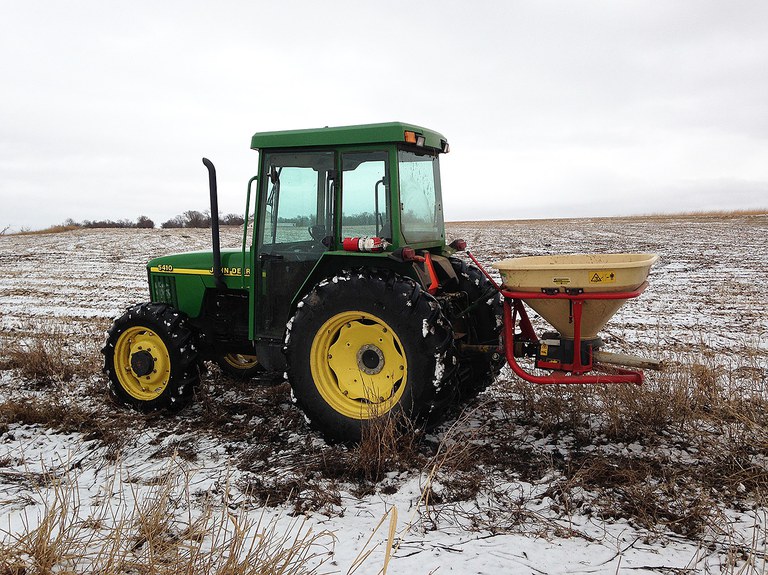
Broadcast snow seeding.
(Chad Carlson, USFWS)
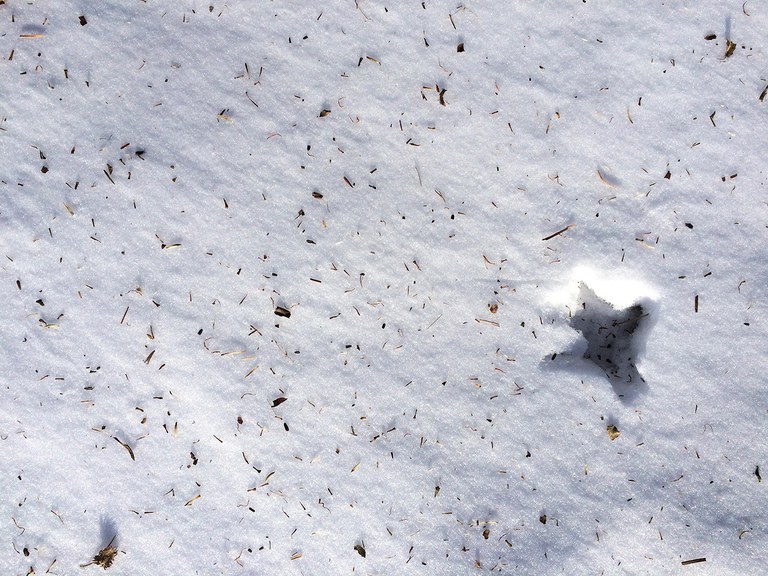
Seed broadcast on snow.
(Kristine Askerooth, USFWS)
Spring
A spring planting usually takes place in North Dakota from late April to mid-June. See recommendations specific to your Major Land Resource Area (USDA 2015).
An early spring seeding may favor species such as cool-season grasses, sedges and certain forbs. This contrasts with a later spring seeding that favors warm-season grasses and certain forbs. Some forbs require stratification and may not germinate until the required environmental conditions are reached in subsequent years (Smith, et al. 2010).
Summer
A summer planting takes place in mid to late summer. Summer plantings are not recommended because of the potential for drought and onset of cold temperatures, both of which can harm newly emerged plants (Smith, et al. 2010).
Data from Larson (2011) indicate that summer plantings (June 8 to September 1) had the lowest success rates in western Minnesota and eastern North Dakota. In wet areas, where this season may be the only option, selection of specific species that germinate and mature quickly may increase overwinter survival.
Snow or Frost
Snow or frost seeding is a dormant planting that occurs late in the winter when temperatures are above freezing during the day and drop below freezing at night. The freezing and thawing action can improve seed-to-soil contact.
Individuals in eastern North Dakota and western Minnesota who utilize this technique are attempting to seed on top of the snow or frozen soil using a broadcast seeder. As freezing and thawing occurs, the seed is embedded into the saturated soils. Germination rates for snow seeding, compared with other seeding times, are unknown.
Proponents of snow seeding note that one of the prominent benefits is that the seed is in the soil less time, compared with a fall dormant seeding; thus, predators and pathogens have fewer opportunities to affect seed (Smith, et al. 2010).
Overall Perspective on Timing
Some sources indicate that the optimal method and time to seed is a dormant-season broadcast seeding onto Roundup Ready soybean stubble (Rowe 2008, Helzer, et al. 2010, Larson et al. 2011) because:
- the seeds do not need to be cleaned to pass through the drill
- results are more natural looking because you cannot see rows
- equipment costs are reduced
- some forb seeds germinate better if placed on the surface (Rowe 2010)
Selecting Species to Seed
Establishing a diverse, native plant community is critical to produce a reconstruction capable of regenerating and providing long-term plant succession (Smith et al. 2010). Diverse seed mixtures increase the likelihood of long-term resilience (Biondini 2007) and allow for successful establishment of the target community (Piper and Pimm 2002). The fact that a high-diversity planting provides for ecological resilience, reduced weed invasion and season-long resources for herbivores, pollinators and other wildlife is well-documented (Tilman 1997, Pokorny 2002, Blumentahl 2003, Pokorny et al. 2004, Pokorny et al. 2005, Sheley and Half 2006, Helzer et al. 2010).
Functionally, the inclusion of forbs in these mixtures appears to be necessary in attempts to restore variables such as nutrient cycling and energy flow (Pokorny et al. 2005). Likewise, a diverse mix plays an important role in the belowground community by providing a well-developed root system to sustain the plants through climate variations, fire and herbivory (Guo et al. 2006). Sheley and Half (2006) indicated that seeding a wide range of forbs increases the likelihood of establishment under variable weather conditions, and once established, a diverse mixture outcompetes weeds better and should persist longer.
In addition, seed mixtures with high forb densities have been shown to reduce densities of invasive species. Norland et al. (2013) identified that Canada thistle can be reduced through the inclusion of forbs that are functionally similar to it and seeded at high rates (identified as “spiked” mixtures). The spiked native forbs were seeded at a rate of approximately 100 to 300 seeds/square feet. The seeding resulted in a reduction of Canada thistle in the first three growing seasons and a tapering into a plant community similar to native prairie compositions by the fifth and sixth growing seasons.
The native forbs chosen for the spike mix have naturally occurring pathogens and predators that eventually reduce their dominance in the planting (Norland et al. 2013). In the end, the use of multiple forbs may help overcome several obstacles because some of the species likely will germinate despite competition and North Dakota’s dynamic weather conditions (Tilman and Downing 1994, Sheley and Half 2006).
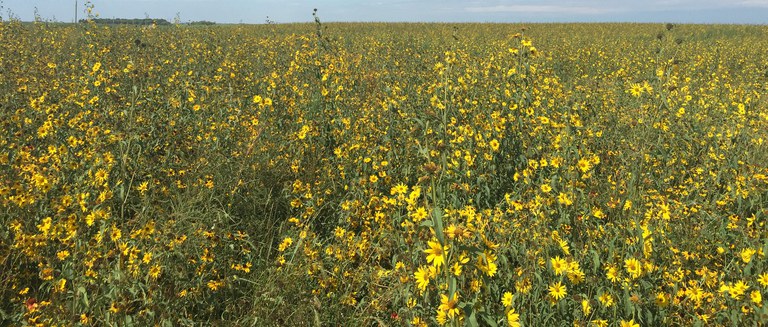
A spiked seed mixture helps to compete with weeds.
(Cami Dison, USFWS)
Further supporting the benefits of increased species diversity, Norland et al. (2015) found that approximately 20 species in a mixture (including grasses and forbs) provided the highest probability of success. They also advocated for inclusion of a diverse forb component in the mix. This information was based on their assessment of reconstructed sites in eastern North Dakota and western Minnesota.
Similarly, Guo et al. (2006) identified that at least 16 species were necessary and not more than 32 species promoted long-term productivity. Other opportunities such as Precision Prairie Reconstruction (Grygiel et al. 2009) may provide better opportunities for the inclusion of rare species if desired.
Considering species selection, Norland et al. (2015) suggest avoiding five or fewer grasses, and excessively low (less than 10) and excessively high (greater than 30) forb species. Rowe (2010) documents that most practitioners have reduced the seeding rates of grasses relative to forbs, which has improved forb establishment, resulting in a more diverse reconstruction.
Smith et al. (2010) suggest six grasses, three sedges and 25 forbs for seedings in the tallgrass prairie, with a planting ratio of 50-to-50 grass-to-forb seed. Piper and Primm (2002) show that as diversity increases in a seed mixture, dominant species stand a better opportunity to out-compete subdominants; therefore, excessively high diversity mixes and inclusion of numerous rare species at low densities may not be worth the cost and effort.
Several practical (for example, seed cost, seed availability, goal of seeding) and ecological (slope and aspect, soils, hydrology) factors should be considered when selecting species to seed. Probably the best resource available to address the ecological factors is ecological site descriptions (ESD) (Sedivec and Printz 2012).
Functional groups for specific climax communities can be identified by reviewing the particular ESD presented by Sedivec and Printz (2012). Community-specific factors provided on plant composition, general functional groups (grasses, forbs, shrubs, etc.) and community pathways provide valuable information for developing site-specific seed mixes and management strategies.
For each ESD, climactic data, growth curves, soil data and water features are documented. These factors may help determine the timing and methods for seeding the site, as well as develop a plan for post-seeding management. Having multiple ESDs within a single reconstruction site is common.
Despite this, some reconstructions may utilize one seed mix and apply it uniformly across a single unit; however, a preferable approach may be to develop various seed mixes based on a unit’s multiple ecological sites, as reported by Sedivec et al. (2014). This is known as a sculptured seeding. The longevity and diversity of reconstructed sites can be enhanced by sculpturing the seeding (Jacobson et al. 1994).
Seed Sources
Local ecotype seed sources should be used in prairie reconstructions (Shirley 1994, Packard and Mutel 1997, Helzer et al. 2010, Smith et al. 2010). Various authors have a number of criteria to determine what can be considered “local.”
Schramm (1978) suggested a 200-mile radius, but also to consider the east-west rainfall regimes as a better guide for regional variability. Similarly, Thornburg (1982) suggested that native seed should not be moved more than 300 miles north or 200 miles south of its point of origin.
These precautionary ranges are intended to prevent problems with genetic drift, winter hardiness, longevity and disease. Seed vendors should know the origin of seed they are selling, and land managers need to know what seed varieties are appropriate for their site.
Special caution should be used when seeding tallgrass prairie species in an area of mixed grass prairie to ensure that nonlocal species are not introduced accidentally.
Sometimes native harvested seed can be purchased from vendors, but more than likely harvesting is a task that needs to be completed individually using mechanical or hand harvest methods.
Native prairie typically is harvested in the fall (for example, September) using a combine, seed stripper or flail vacuum, or by hand. While fall is an optimal season for harvesting warm-season species, it may not be the best time to harvest earlier-blooming species (for example, early blooming forbs, and native cool-season grasses). These species may require hand harvesting earlier in the season to create a more diverse mixture.
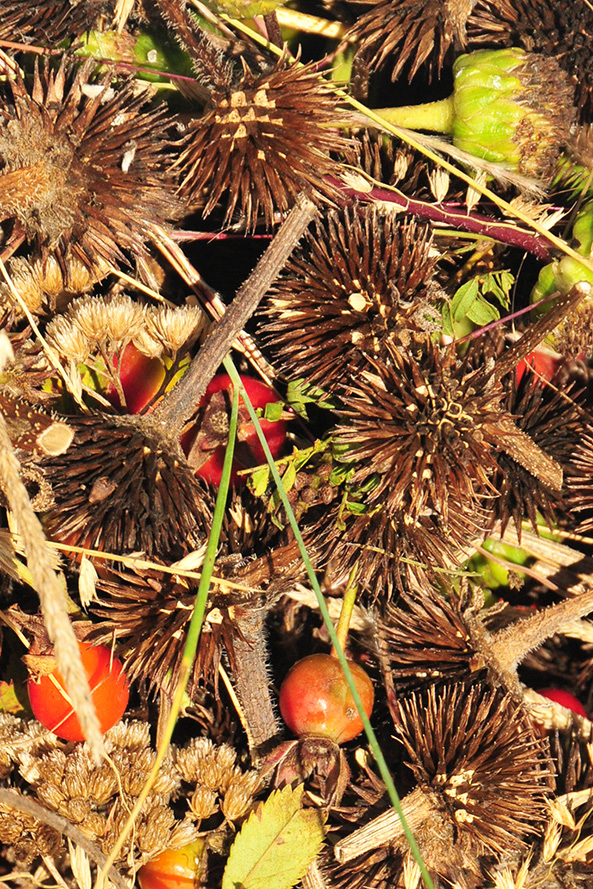
Native seed
(Tom Koerner, USFWS)
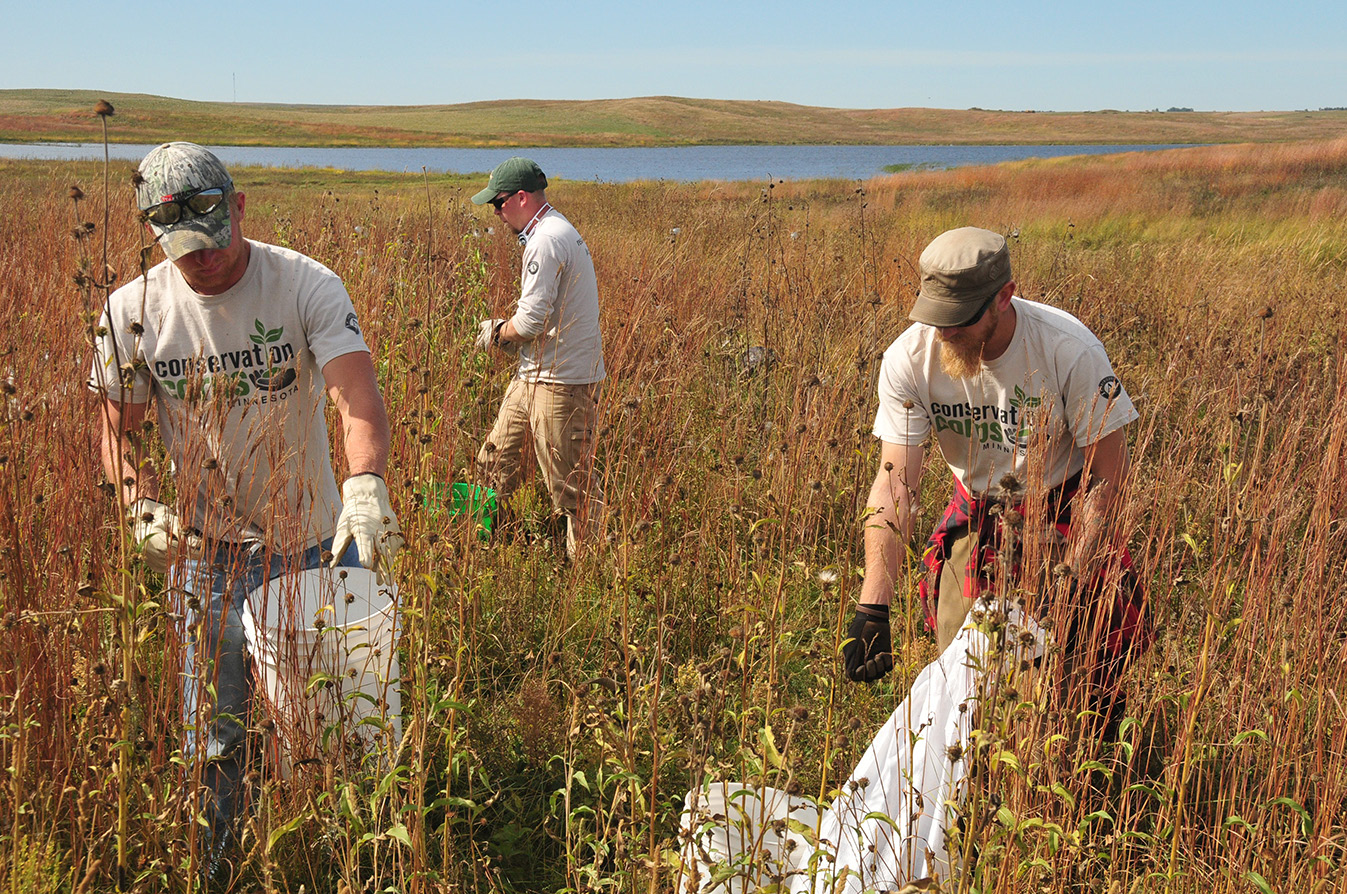
Seed harvest.
(Tom Koerner, USFWS)
If the decision is made to implement a native harvesting program, several resources are available (for example, Houseal 2007, Smith et al. 2010), and collaboration with individuals already involved in this effort is encouraged.
Cultivars are cultivated varieties of native grass and forb species that have been developed by the USDA Plant Materials Center. Cultivar grass varieties are developed through collecting and propagating seeds from individual plants from multiple locations to select for certain traits.
For example, little bluestem has two developed ecotypes: Badlands and Itasca. The Badlands ecotype was developed for early maturing, good plant vigor, seed production, disease resistance, etc. Origins include a composite of 68 vegetative collections from various native sites across North and South Dakota. In comparison, the Itasca composites of 72 vegetative collections are from eastern North Dakota, north-central South Dakota, and central and northwestern Minnesota .
Cultivars provide a straightforward method to ensure that purchased seed will grow in the specific area of the reconstruction. The USDA Plant Materials Center provides numerous publications on its website to assist with identifying cultivars that are specific to your area (see link in Appendix A).
Cultivars do not exist for all species that may be desired in a seed mixture, and caution should be used when purchasing species if the origin or variety is not listed. Working with seed vendors to find local ecotype seed or harvesting the targeted species are options for inclusion of specific species. Most native seed suppliers can custom blend, bag and import (if necessary) to meet needs.
When a bag of seed is obtained, the entire bag is known as “bulk” seed. Seeding rates are based on pure live seed (PLS), which factors in the purity and germination rate of the seed. Purity measures weeds and inert matter mixed with the actual seed. Germination accounts for the percentage of dead or dormant seed and is an indicator of the percentage of seed that will sprout and grow.
Determining the PLS of the bulk seed is important. PLS is determined by multiplying the percent of pure seed by the percent of germination and dividing by 100 (USDA 2015). To identify the pounds of bulk seeding rate per acre, take the pounds of PLS recommended rate per acre (see USDA 2015) and divide by the percent of PLS.
For calculating seeds per square foot, take the number of seeds of the individual species per pound (USDA 2015) x the total PLS pounds divided by acres to seed x 43,560 feet2 per acre.
To order seed from a vendor, you need the following information:
- Species name (for example, big bluestem)
- Full seeding rate (this is provided in USDA [2015]; for big bluestem, 7.9 PLS pounds per acre)
- Percent of the individual species (typically for purchasing seed, you will go by pounds of seed) you want in the mix (you can have only 100 percent for all species in the mix, so you likely will have anywhere from 1 to 7 percent of a species in a mix, depending on diversity)
- Seeded PLS pounds per acre (this is the full seeding rate x the percent of the species in the mix)
- Number of acres you plan to seed
- Total PLS pounds (this is the number you will provide the vendor); this is the seeded PLS pounds per acre x the number of acres
Make calculations in the native seeding planning sheets that are provided by several agencies (See Appendix A).
Optimum seeding rates have not yet been determined for native species as they have been for many introduced species (Pyke and Archer 1991). Seeding rates for species such as big bluestem, Indiangrass and switchgrass have decreased through the years because of the tendency of these species to dominate. In areas dominated by native cool-season grass, the same can occur, especially when using cultivars of green needlegrass, slender wheatgrass, western wheatgrass, and Canada wildrye.
Seeding rates tend to increase with soil productivity, annual rainfall and perennial weed pressure. For example, major moisture regime changes occur from the Red River Valley to more drought-prone western parts of North Dakota. According to the USDA (2015), seeding rates in western Minnesota and eastern North Dakota average 25 to 40 seeds per ft2 for a diverse mixture of grasses, forbs and small shrubs.
Smith et al. (2010) recommend a minimum of 40 seeds/foot2, and for slopes of 3-to-1 or greater, a minimum of 60 to 80 seeds/ft2 are recommended because of erosion concerns. Sedivec et al. (2014) estimate that a reconstruction should include approximately 10 to 12 PLS pounds per acre.
The USDA (2015) has a listing that identifies seeds per pound, seeds per foot2 and PLS pounds per acre for numerous species. If a species is not on this list, several books list seed weights for the tallgrass prairie, including:
- “The Tallgrass Prairie Center Guide to Prairie Restoration in the Upper Midwest” by Daryl Smith, Dave Williams, Greg Houseal and Kirk Henderson. 2010. The University of Iowa Press, Iowa City
- “Restoring the Tallgrass Prairie” by Shirley Shirley. 1994. The University of Iowa Press, Iowa City
- “Tallgrass Prairie Center Native Seed Production Manual” by Greg A. Houseal. 2007. The Tallgrass Prairie Center, Cedar Falls
Establishment Phase
The establishment phase section documents expectations associated with the initial and succeeding plant communities. As with native grasslands, management actions such as burning and grazing will be necessary to sustain the native plants. Finally, suggestions for evaluation methods are provided using example objectives.
Step 5 – Management Actions
Pre-establishment
Grasslands of North Dakota historically relied on climate, fire and herbivory to support a patchy, heterogeneous composition of native vegetation (Severson and Sieg 2006). Similarly, modern-day prairie reconstructions will require defoliation (burning and grazing) to maintain integrity and diversity (Smith et al. 2010).
An establishment period for prairie reconstructions can last three to five years, depending on several variables (for example, moisture regimes; Packard and Mutel 1997, Smith et al. 2010).
The first year of a seeding often produces a dominant cover of annual weeds. Mowing may be necessary in wetter areas of the tallgrass prairie where annual weeds are tall and more robust. Reconstructionists in Minnesota and Iowa frequently utilize mowing in the first year and possibly the second because the low light levels in a closed canopy may reduce emergence and growth of the native plants (Williams et al. 2007). However, in the drier parts of the tallgrass and mixed grass prairie, mowing is not as common.
Mowing likely is a site-by-site decision, depending on the thickness of the annual weed cover and the possible impacts to native seedlings (for example, the litter created post-mowing, damage to seeded plants if mowed too low). If mowing is utilized, set the mower to a height of 8 to 10 inches and implement in late June prior to weed seed viability, and not too late so that native plants have time to benefit prior to winter (USDA 2015).
In years two to four, more of the planted species becomes prominent and the area tends to have fewer annual weeds. After year two, Funk et al. (2007) found that native plants with similar resource-use traits (functional traits) reduce problematic exotic species in reconstructions. Specific to North and South Dakota, Norland et al. (2013) experienced similar outcomes, as described previously in Selecting Species to Seed.
Year three usually provides enough litter fuel to carry a fire, and therefore a prescribed burn is implemented during the third or even fourth year (Rowe 2010). Howe (1994) notes that fire season affects relative abundance of planted species in reconstructions. Early flowering species seem to favor summer burns, while later flowering species favor spring burns.
Early spring burns encourage cool-season species, and late spring burns encourage warm-season species and suppress cool-season species (Wark et al. undated). At sites where managers are content with species density and phenological distribution, a fall burn to remove accumulated litter is recommended (Wark et al. undated).
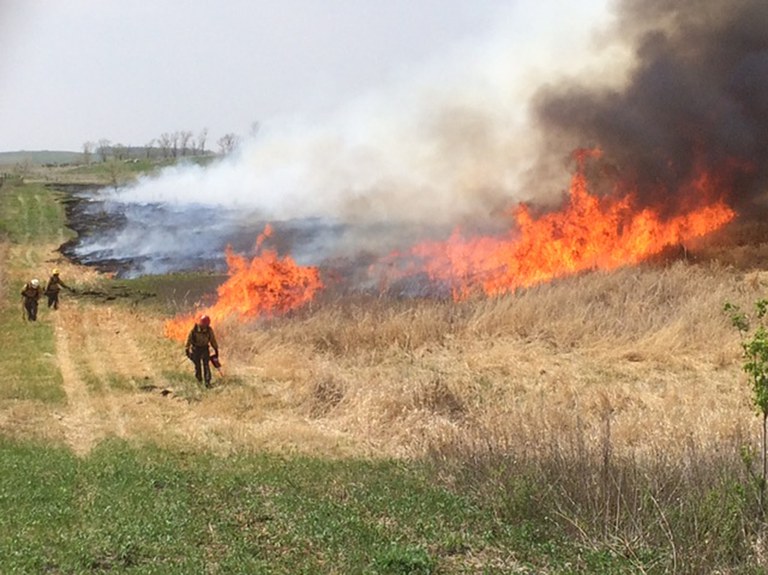
Prescribed burn.
(Cami Dixon, USFWS)
Grazing is not recommended until the third or fourth year. Prior to that time, seedlings do not have well-developed root systems with adventitious roots above the sown seed (USDA 2015). Often reconstructionists in North Dakota will burn in year three, then do the initial graze in years four or five. Once the seeding is established, defoliation techniques (burning and grazing) occur regularly throughout the life of the stand.
One noteworthy of mention is that Canada thistle and other perennial weeds may become problematic throughout the seeding. Mowing or spraying may not be the best solution for control; rather, competition from the native plants seem to provide optimal control possibilities (for example, Norland et al. 2013).
Opening the canopy through mowing may improve opportunities for Canada thistle growth because it thrives in open-canopy areas (Bakker 1960, Hodgson 1968). Mowing the main shoot of Canada thistle stimulates sprouting from other root buds and more vegetative stems produced, creating opportunities for spread (Larson et al. 2013). Herbicide use may affect non-target plants negatively and only provide short-term alleviation from the invading plant.
Post-establishment
Cool-season invasive grasses pose the most concerns for invasion beyond the establishment phase. Annual or noxious weeds tend to be opportunistic early in the reconstruction process and following defoliations; however, cool-season invasive grasses usually invade gradually and during the long term. Appropriate site preparation (Smith et al. 2010) and seed selection (Norland et al. 2013) will provide the foundation for reducing invasive plant problems during and beyond the establishment phase.
Smooth brome and Kentucky bluegrass are prevalent across North Dakota, and without proper planning, will invade and dominate reconstructions. Varying and sometimes conflicting information exists for managing prairies invaded by these species.
That grasslands devoid of burning and grazing will deteriorate is apparent (Murphy and Grant 2005), negating the intended goals and objectives of the prairie reconstruction. The timing, frequency and method of defoliation depend upon the current vegetation state and the invader targeted for reduction. For example, annual and seasonlong grazing may facilitate Kentucky bluegrass invasion (Murphy and Grant 2005), while burning at a certain phenological stage of smooth brome may reduce invasion and increase warm-season native plants (Willson and Stubbendiek 2000).
Continued research is needed to develop more prescriptive information for reducing the negative effects of smooth brome and Kentucky bluegrass. Recent articles that may be helpful to review for planning purposes include:
- “Kentucky bluegrass (Poa pratensis) invasion in the Northern Great Plains: a story of rapid dominance in an endangered ecosystem” by E.S. Dekeyser, L.A. Dennhardt and J. Hendrickson. 2015. Invasive Plant Science and Management 8(3):255-261
- “Impacts and management of invasive cool-season grasses in the Northern Great Plains: challenges and opportunities for wildlife” by S.N. Ellis-Felege, C.S. Dixon and S.D. Wilson. 2013. Wildlife Society Bulletin 37(3):510-516
- “Impacts of Kentucky bluegrass invasion (Poa pratensis L.) on ecological processes in the Northern Great Plains” by J.L. Printz and J.R. Hendrickson. 2015.. Rangelands 37(6): 226-232
- “Extent of Kentucky bluegrass and its effect on native plant species diversity and ecosystem services in the Northern Great Plains of the United States” by D.A. Toledo, M. Sanderson, K. Spaeth, J. Henderickson and J. Printz. 2014. Weed Science Society of America 7(4):543-552
Natural Failure Rate
Despite implementing the best-known practices to achieve success in a prairie reconstruction, a natural failure rate exists. Uncontrollable factors such as climate, pathogens and unintended human-caused actions (for example, pesticide overspray) may negate the opportunities for success. Ironically, the attempt to reconstruct prairie involves changing a site from a more simplified vegetative state (for example, a crop field or monotype of cool-season invasive grasses) to a more complex state (for example, a diverse native plant community).
Judging the failure rate based on this more simplified state produces expectations for high success (for example, 95 to 100 percent); conversely, in a more complex state such as a reconstruction, success rates are estimated to be around 80 percent (Norland et al. 2015). Research intended to reduce knowledge gaps may not increase the latter success rate, considering that uncontrollable factors persist in complex states (Hildebrand et al. 2005, Suding 2011).
The ideal of controlling all variability to achieve a 100 percent success rate is likely a fallacy and unachievable for prairie reconstructions. By embracing this knowledge, land managers can manage their expectations for prairie reconstruction outcomes. Developing clear goals and objectives, and allowing ample time for the reconstruction to progress beyond establishment will help judge a seeding as a success or failure.
Step 6 - Evaluation
Patience is important and necessary when evaluating the establishment of prairie reconstructions. Warm-season plants may require three growing seasons for full establishment (UDSA 2015) and even may require as long as three to five years, depending on site conditions (Packard and Mutel 1997, Smith et al. 2010).
Environmental factors such as precipitation, drought and temperature can delay seedling emergence and development (USDA 2015). Developing a well-thought-out plan and method for evaluation allows for appropriate measurement of the goals and objectives, and ultimately the success or failure of a seeding.
Identifying an adequate method for evaluation depends on the intended objectives. Monitoring prairie reconstructions often involves evaluating vegetation (examples provided in Step 1 - Setting Goals and Determining Objectives). Prior to implementing any monitoring program, resources such as “A Technical Guide for Monitoring Wildlife Habitat,” “Measuring and Monitoring Plant Populations” and “How to Develop Survey Protocols” (Rowland and Vojta 2013; Elzinga et al.1998; U.S. Fish and Wildlife Service 2013) might be useful in developing an evaluation plan and methods.
The following section details a tiered approach for monitoring reconstructions. Each tier describes potential methods for monitoring certain characteristics of prairie reconstructions. The amount of time, effort and detail needed in each approach varies based on the tier and intended objectives (tier 1 involves the least effort, whereas tier 3 requires the most). These are examples intended to assist land managers with developing site-specific approaches and objectives.
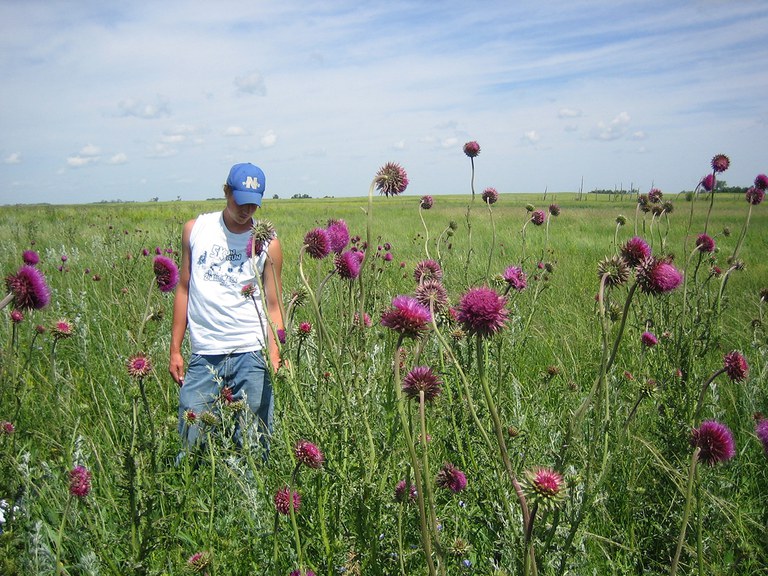
A site invaded with musk thistle.
(Cami Dixon, USFWS)
Tier 1 Monitoring Approach
Example Objective – Planted Species
Reconstruct prairie to a mixture of native plants that is specific to the site, where greater than 90 percent of the seeded species are documented within the first six to eight years of seeding.
The Tier 1 option provides minimal inputs based on the specifics needed to meet the objective. Create a checklist of the seeded species in a spreadsheet or database. Annually walk (or use an all-terrain vehicle) through the seeded field within the same two- to three-week time period and place a check by a species when it is identified. If species are unidentifiable because they are not flowering, multiple walks a year may be necessary.
Walk the full length of the field at various segments across the seeded area. Capture data in the associated spreadsheet or database after each monitoring walk to ensure that an accurate evaluation can take place following year eight.
Tier 2 Monitoring Approach
Example Objective – Plant Community
Plant a site-specific native seed mixture that, on average, provides the following composition: less than 25 percent non-native plants, 30 to 40 percent native forbs and 50 to 70 percent native grasses in the next 15 years.
Tier 2 requires more intensive effort and specific information than Tier 1 because of the need for quantitative data to meet the needs of the objective. The Belt Transect Method (Grant et al. 2004) provides one option for monitoring this objective. This method requires the evaluator to develop a list of plant groupings that will be identified along a transect (in this example objective, the plant groupings could be based on the plants included in the seed mix).
Gathering data with this method is relatively rapid, considering that plant groupings along a transect are often similar (Grant et al. 2004). Transect length and placement varies, depending on the field size, slope and aspect, and ecological sites.
For example, a transect length could vary from 10 meters (large variations in ecological sites) to 100 meters (maybe only a couple of ecological sites). We recommend that a statistician be consulted to ensure that the design is appropriate for evaluating the intended objective.
Data from this method can be entered in a spreadsheet or database to quantitatively measure the percent composition of the targeted plant groupings annually. Grant et al. (2004) provide examples for analyzing data with this method.
Example Objective – Ecological processes
Enable ecological processes on reconstructed prairie by ensuring that litter depths remain in the range indicated for the respective ecological sites across 10-year periods.
Ecological processes generally refer to the water cycle, energy flow and nutrient cycle. Due to the complexities of grasslands, ecological processes are difficult to measure or observe; therefore, as a metric for reconstruction purposes, litter depth is suggested as an overall representation.
Based on the “Indicators of Rangeland Health” (Pellant et al. 2005), litter amount is an indicator for two (hydrologic function and biotic integrity) out of three attributes, suggesting that this is a reasonable metric to monitor for ecological processes. Litter is defined as dead plant material that is detached from the base of the plant and is in contact with the ground (Pellant et al. 2005).
References for the appropriate thickness of the litter are provided in the ecological site descriptions in the “Rangeland Health Reference Sheet.” Again, we recommend that a statistician be consulted to identify the number of litter measurements needed on a site based on the number and acreages of ecological sites.
Data collected can be entered in a spreadsheet or database to quantitatively measure the average litter depths across the indicated period. Proper techniques to measure litter depths in grasslands are found in “Interpreting Indicators of Rangeland Health”.
Example Objective – Grassland Bird
Reconstruct prairie to benefit grassland nesting birds to a site-specific mixture of native plants that provides an average visual obstruction (height and density) of 2 to 4 decimeters in the next 10 years.
The Robel pole (Robel et al. 1970) is a common method to collect visual obstruction data for grasslands. A Robel pole is a 1-meter-tall pole with a spike on the base for securing in the ground. The pole has red or black marks in half and whole decimeter increments, starting with zero at the base and ending with 10 or 15 at the top.
This rapid technique measures the height and vertical density of standing vegetation by reading the last mark visible on the pole. Data are used to measure residual forage or are correlated with grassland bird nesting cover. The accuracy of data depends on appropriate training for the observers because ocular estimations can be variable.
Data from this method can be entered in a spreadsheet or database to quantitatively measure the average visual obstruction of the prairie during the stated period. We recommend that a statistician be consulted to identify the number of Robel pole readings needed for a prairie reconstruction. More information on the Robel pole method.
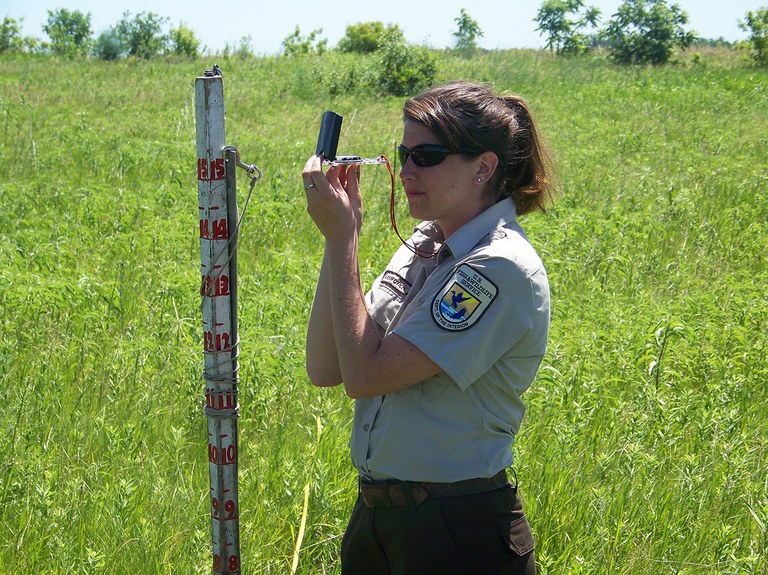
Robel pole.
(J.B. Bright, USFWS)
Tier 3 Monitoring Approach
Example Objective - Pollinator
Reconstruct prairie to a site-specific mixture of native plants that annually produces flowering species throughout the growing season, with average canopy coverage of 50 to 70 percent forbs.
Tier 3 requires intensive monitoring because of the need to collect data on the percentage of canopy cover for each species. A suggested protocol involves 25-meter transects with three frames (6 meters, 12 meters and 18 meters) per transect. Each ¼-meter frame requires identification of each species and an associated canopy cover percentage.
The number of transects per field should be determined based on consultation with a statistician. Each transect should be monumented to ensure that the survey is completed at the same location every year. Data are summarized using the average canopy cover for each plant identified. An associated spreadsheet or database can be developed to facilitate analysis.
Because of concerns with variability in measuring canopy cover, the same individual should monitor the field every year if possible. Another method for reducing observer variability is to train all observers in using photographs and computer-generated canopy covers (for example, use GIS software for this) so that everyone involved in the monitoring process has been calibrated. Calibration should be performed yearly for each observer. Double-observer methods also can be utilized to help reduce variability.
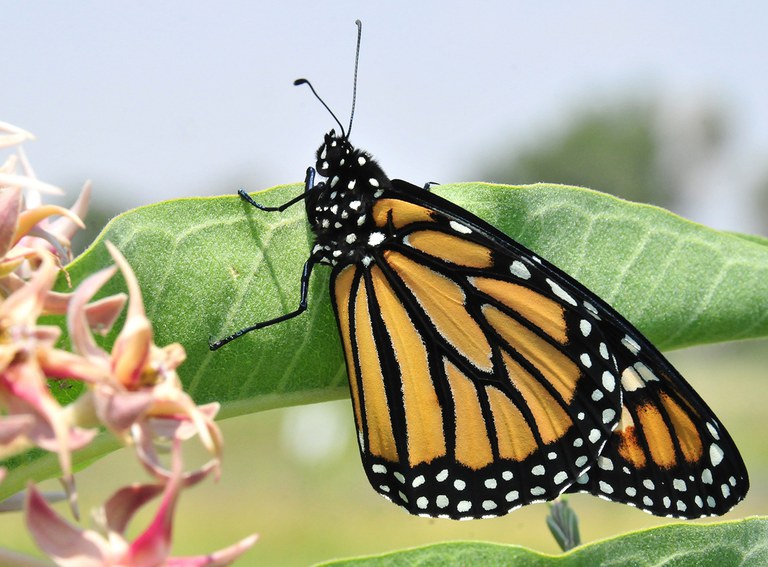
Pollinator.
(Tom Koerner, USFWS)
Photo Points
Photographs can be used to supplement monitoring approaches by providing an overall view of the dominant vegetative cover and site conditions. Here are some factors to consider when taking photos:
- Mark permanent locations where your photos will be taken (for example, a monumented transect starting point)
- Ensure that the identical scene is photographed each year
- Take the photo at exactly the same time each year
- Use the same camera at the same zoom or focus
- On subsequent years, bring the previous year’s photo to assist with taking the photo from exactly the same position
As a final suggestion, you may want to use a fence post or survey pole as the center point of the photo each year just as a benchmark for the vegetation height.
Appendix A. Prairie Reconstruction Resource Guide
Seeding Calculators
Natural Resources Conservation Service, Iowa
Natural Resources Conservation Service, North Dakota (see link to ND-CPA-9 – “Planning or Data Sheet for Grass and/or Legume Seeding”)
Information on Species
Prairie Moon Nursery
Useful information across website, including its annual catalogs
Tallgrass Prairie Center Native Seed Production Manual
Natural Resources Conservation Service Herbaceous Vegetation Establishment Guide
Natural Resources Conservation Service Plant Materials Center
Natural Resources Conservation Service Range Planting (South Dakota)
Daryl Smith, Dave Williams, Greg Houseal, Kirk Henderson (Book)
The Tallgrass Prairie Center Guide to Prairie Restoration in the Upper Midwest (2010),
Developing a seed mix using a seed calculator – Pages 30-34
Details on seed dormancy – Pages 239-247
Prairie Seedling and Seeding Evaluation Guide
Literature Cited
Ambrose, L.G., and S.D. Wilson. 2003. Emergence of the introduced grass Agropyron cristatum and the native grass Bouteloua gracilis in a mixed-grass prairie restoration. Restoration Ecology11(1):110-115.
Bakker, D. 1960. A comparative life-history study of Cirsium arvense (L.) Scop. and Tussilago farfara L., the most troublesome weeds in the newly reclaimed polders of the former Zuiderzee. Pp. 205-222 in the biology of weeds (J.L. Harper, editor). Blackwell Scientific Publishers Ltd., United Kingdom.
Bakker, J.D., J. Christian, S.D. Wilson and J. Waddington. 1997. Seeding blue grama in old crested wheatgrass fields in southwestern Saskatchewan. Journal of Range Management 50:156–159.
Bakker, J.D., S.D. Wilson, J.M. Christian, X. Li, L.G. Ambrose and J. Waddington. 2003. Contingency of grassland restoration on year, site, and competition from introduced grasses. Ecological Applications 13(1). pp. 137–153.
Biondini, M. 2007. Plant diversity, production, stability, and susceptibility to invasion in restored northern tall grass prairies (United States). Restoration Ecology 15: 77-87.
Blumenthal, D.M., N.R. Jordan and E.L. Svenson. 2003. Weed control as a rationale for restoration: the example of tallgrass prairie. Conservation Ecology 7(1): 6. Available online at www.consecol.org/vol7/iss1/art6/
Brandt, J., K. Henderson and J. Uthe. 2015. Integrated roadside vegetation management technical manual. Cedar Falls: Roadside Management Program, University of Northern Iowa. 83 pp.
Crall, A.W., C.S. Jarnevich, B. Panke, N. Young, M. Renz and J. Morisette. 2013. Using habitat suitability models to target invasive plant species surveys. Ecological Applications 23:60-72.
Duebbert, H.F., E.T. Jacobson, K.F. Higgins and E.B. Podoll. 1981. Establishment of seeded grasslands for wildlife habitat in the Prairie Pothole Region. U.S. Fish and Wildlife Service, Special Scientific Report, Wildlife No. 234. Jamestown, N.D: Northern Prairie Wildlife Research Center Online. Available online .
Elzinga, C.L., D.W. Salzer and J.W. Willoughby. 1998. Measuring and monitoring plant populations. U.S. Department of Interior Bureau of Land Management Technical Reference 1730-1. Denver, Colo. 477 pp.
Foster, B.L., C.A. Murphy, K.R. Keller, T.A. Aschenbach, E.J. Questad and K. Kindscher. 2007. Restoration of prairie community structure and ecosystem function in an abandoned hayfield: A sowing experiment. Restoration Ecology 15: 652–661.
Funk, J.L., and P.M. Vitousek. 2007. Resource-use efficiency and plant invasion in low-resource systems. Nature 446: 1079-1081.
Grant, T.A., E.M. Madden, R.K. Murphy, K.A. Smith and M.P. Nenneman. 2004. Monitoring native prairie vegetation: the belt transect method. Ecological Restoration 22:106-112.
Guo, Q., T. Shaffer and T. Buhl. 2006. Community maturity, species saturation, and the variant diversity-productivity relationships in grasslands Ecological Letters. 9: 1284-1292.
Grygiel, C.E., J.E. Norland and M.E. Biondini. 2009. Precision prairie reconstruction (PPR): a technique for increasing native forb species richness in an established grassmatrix. Ecological Restoration 27: 458-466.
Grygiel, C.E., J.E. Norland and M.E. Biondini. 2010. Can carbon and phosphorous amendments increase native forbs in a restoration process? A case study in the Northern Tall-grass Prairie (U.S.A.). Restoration Ecology 20: 122-130.
Hamdoun, A.M. 1970. The effects of different levels of nitrogen upon Cirsium arvense (L.) Scop. Plants grown from seeds and root fragments. Weed Restoration 10:121-125.
Helzer C., B. Kleiman, C. O’Leary and B. Glass. 2010. Lessons learned from the grassland restoration network: 2003-2010. 22nd Annual North American Prairie Conference.
Hilderbrand, R.H., A.C. Watts and A.M. Randle. 2005. The myths of restoration ecology. Ecology and society10:19.
Hodgson, J.M. 1968. The nature, ecology, and control of Canada thistle. Technical Bulletin of the U.S. Department of Agriculture, No. 1386. Washington, D.C.: United States.
Houseal, G.A. 2007. Tallgrass Prairie Center’s Native Seed Production Manual. University of Northern Iowa, Cedar Falls, Iowa. 122 pp.
Howe, H.F. 1994. Response of early- and late-flowering plants to fire season in experimental prairies. 4 (1): 121-133.
Jacobson, E.T., D.B. Wark, R.G. Arnott, R.J. Haas and D.A. Tober. 1994. Sculptured seeding, an ecological approach to revegetation. Restoration and Management Notes 12:46-50.
Johnson, R.R., M.E. Estey, D.A. Granfors, R.E. Reynolds and N.D. Niemuth. 2010. Delineating grassland bird conservation areas in the U.S. Prairie Pothole Joint Venture. Journal of Fish and Wildlife Management 1:38-42.
Jordan, W.R., III. 1988. Ecological restoration. Pages 311– 316 in E.O. Wilson and F.M. Peter, editors. Biodiversity. National Academy Press, Washington, D.C., USA.
Jordan, N., D. Larson and S. Huerd. 2008. Soil modification by invasive plants: effects on native and invasive species of mixed-grass prairies. Biological Invasions 10: 177-190.
Larson, D.L., J. B. Bright, P. Drobney, J.L. Larson, N. Palaia,, P. Rabie, S. Vacek and D.Wells. 2011. Effects of planting method and seed mix richness on early stages of tallgrass prairie restoration. Biological Conservation 144: 3127-3139.
Larson, D.L., J.B. Bright, P. Drobney, J.L. Larson, N. Palaia, P. Rabie, S. Vacek and D. Wells. 2013. Using prairie restoration to curtail invasion of Canada thistle: the importance of limiting similarity and seed mix richness. Biological Invasions. 15:2049-2063.
Larson, T.K. 2011. Prairie Restoration Outcomes in the Northern Tallgrass and Mixed Grass Prairie Eco-region. Master’s Thesis. North Dakota State University. Fargo, N.D. 93 pp.
Laubhan, M.K., B. Flanders-Wanner and R.A. Laubhan. 2012. A conceptual approach to evaluating grassland restoration potential on Huron Wetland Management District, South Dakota. U.S. Department of Interior, Fish and Wildlife Service, Biological Technical Publication FWS/BTP-R6016-2012, Washington, D.C. 19 pp.
Levang-Brilz, N., and M.E. Biondini. 2002. Growth rates, root development and nutrient uptake of 55 plant species from the Great Plains, Grasslands, USA. Plant Ecology 165:117-144.
McLauchlan, K. 2006. The nature and longevity of agricultural impacts on soil carbon and nutrients: A review. Ecosystems 9:1364-1382.
Martin, L.M., and B.J. Wilsey. 2006. Assessing grassland restoration success: relative roles of seed additions and native ungulate activities. Journal of Applied Ecology 43: 1098-1109.
Martin, L.M., and B.J. Wilsey. 2014. Native-species seed additions do not shift restored prairie plant communities from exotic to native states. Basic and Applied Ecology 15: 297-304.
Meyer, M.H., and V.A. Gaynor. 2002. Effect of seeding dates on establishment of native grasses. Native Plants Journal 3(2):132-138.
Murphy, R.K., and T.A. Grant. 2005. Land management history and floristics in mixed-grass prairie, North Dakota, USA. Natural Areas Journal 25(4):351-358.
Newman, G.J., and E.F. Redente. 2001. Long-term plant community development as influenced by revegetation techniques. Journal of Range Management 54:717-724.
Niemuth, N.D., R.E. Reynolds, D.A. Granfors, R.R. Johnson, B. Wangler and M.E. Estey. 2008. Landscape-level planning for conservation of wetland birds in the U.S. Prairie Pothole Region. In J.J. Millspaugh and F.R. Thompson (Eds.), Models for planning wildlife conservation in large landscapes, Elsevier Science, Burlington, Mass.
Norland, J., T. Larson, C. Dixon and K. Askerooth. 2015. Outcomes of past grassland reconstructions in eastern North Dakota and northwestern Minnesota: analysis of practices. Ecological Restoration 33(4): 409-417.
Norland, J., S. Fasching, C. Dixon, K. Askerooth, K. Kelsey and G. Wang. 2013. Reduced establishment of Canada thistle (Cirsium arvense) using functionally similar native forbs. Ecological Restoration 31(2): 143-146.
Packard, S., and C.F. Mutel. 1997. The Tallgrass restoration handbook for prairies, savannas and woodlands. Society for Ecological Restoration: Washington, D.C.
Pellant, M., P. Shaver, D.A. Pyke and J.E. Herrick. 2005. Interpreting Indicators of Rangeland Health. U.S. Department of Interior, Bureau of Land Management, Technical Reference 1734-6.
Piper, J.K., and S.L. Pimm. 2002. The creation of diverse prairie-like communities. Community Ecology. 3:2. pp. 205-216.
Pokorny, M.L. 2002. Plant functional group diversity as a mechanism for invasion resistance. M. S. thesis. Montana State University, Bozeman, Mont.
Pokory, M.L., R.L. Sheley, T.J. Svejcar and R.E. Engel. 2004. Plant species diversity in a grassland community: evidence for forbs as a critical management consideration. Western North American Naturalist 64(2):219-230.
Pokorny, M.L., R.L. Sheley, C.A. Zabinski, R.E. Engel and T.J. Svejcar. 2005. Plant functional group diversity as a mechanism for invasion resistance. Restoration Ecology 13(3): 448-459.
Pyke, D.A., and S. Archer. 1991. Plant–plant interactions affecting plant establishment and persistence on revegetated rangeland. Journal of Range Management 44:550–557.
Reynolds, R.E., T.L. Shaffer, C.R. Loesch and R.R. Cox Jr. 2006. The Farm Bill and duck production in the Prairie Pothole Region: increasing the benefits. Wildlife Society Bulletin 34:963-974.
Robel, R.J., J.N. Briggs, A.D. Dayton and L.C., Hulbert. 1970. Relationships Between Visual Obstruction Measurements and Weight of Grassland Vegetation, Journal of Range Management 23:295.
Roundy, B.A., and C.A. Call. 1988. Revegetation of arid and semiarid rangelands. Pages 607–635 in P.T. Tueller, editor. Vegetation science applications for rangeland analysis and management. Kluwer, Dordrecht, The Netherlands.
Rowe, H. 2008. The influence of soil inoculum and nitrogen availability of high-elevation steppe communities invaded by Bromus tectorum. Restoration Ecology 16: 1-9.
Rowe, H. 2010. Tricks of the trade: techniques and opinions from 38 experts in tallgrass prairie restoration. Restoration Ecology 19:253-262.
Rowland, M.M., and C.D. Vojta. 2013. A technical guide for monitoring wildlife habitat. U.S. Department of Agriculture, Forest Service. General Technical Report WO-89. Washington, D.C.
Schramm, P. 1978. The “do’s and don’ts” of prairie restoration. Pages 139-150. In D.C. Glenn-Lewin and R.Q. Landers (eds.). Proceedings of the Fifth North American Prairie Conference. Iowa State University, Ames, Iowa.
Schramm, P. 1990. Prairie restoration: A 25-year perspective on establishment and management. Proceedings of the Twelfth North American Prairie Conference. Department of Biology. Knox College. Galesburg, Ill. pp. 169-168.
Sedivec, K.K., C. Piper, J.L. Printz, A. Wick, A. Daigh and R. Limb. 2014. Successful reclamation of lands disturbed by oil and gas development and infrastructure construction. North Dakota State University Extension Service, Fargo, N.D. 15 pp.
Sedivec, K.K., and J.L. Printz. 2012. Ecological sites of North Dakota: a pictorial guide of ecological sites common to North Dakota. North Dakota State University Extension Service, Fargo, N.D. 28 pp.
Severson, K.E., and C.H. Sieg. 2006. The Nature of Eastern North Dakota: Pre-1880 Historical Ecology. North Dakota State University, Fargo, N.D.
Sheley, R.L., and M.L. Half. 2006. Enhancing native forb establishment and persistence using a rich seed mixture. Restoration Ecology 12(4): 627-635.
Shirley, S. 1994. Restoring the tallgrass prairie. University of Iowa Press, Iowa City, Iowa. 330 pp.
Smith, D., D. Williams, G. Houseal and K. Henderson. 2010. The Tallgrass Prairie Center guide to prairie restoration in the upper Midwest. University of Iowa Press, Iowa City, Iowa. 301 pp.
Suding, K.N., 2011. Toward an era of restoration in ecology: successes, failures, and opportunities ahead. Annual Review of Ecology, Evolution, and Systematics, 42:465-486.
Thornburg, A.A. 1982. Plant materials for use on surface-mined lands in arid and semiarid regions. USDA-SCS SCS-TP-157. 88 pp.
Tilman, D. 1997. Community invasibility, recruitment limitations, and grassland biodiversity. Ecology 78(1): 81-92.
Tilman, D. and J. Downing. 1994. Biodiversity and stability in grasslands. Nature 367:363-365.
Uden, D.R., C.R. Angeler, L. Corral and K.A. Fricke. 2015. Adaptive invasive species distribution models: a framework for modeling incipient invasions. Biological Invasions 17(10): 2831-2850.
U.S. Department of Agriculture, NRCS. 2015. Herbaceous Vegetation Establishment Guide. FOTG - Section I - Reference Subject - Plant Materials. Bismarck, N.D. 21 pp.
U.S. Fish and Wildlife Service. 2013. How to develop survey protocols, a handbook (Version 1.0). Fort Collins, Colo.: U.S. Department of Interior, Fish and Wildlife Service, National Wildlife Refuge System, Natural Resource Program Center, Fort Collins, Colo.
Vasquez, E., R. Sheley and T. Svejcar. 2008. Creating invasion resistant soils via nitrogen management. Invasive Plant Science and Management 1:304-314.
Wark, D.B., L.K. Gabruch, C. Penner, R.J. Hamilton and T.G. Koblun. Undated. Revegetating with Native Grasses in the Northern Great Plains: Professional’s Manual. Joint Publication of Agriculture and Agri-Food Canada’s Greencover Canada Program, Canada’s Department of Fisheries and Oceans, Ducks Unlimited Canada, and Proven Seed. 60 pp.
Williams, D., L. Jackson and D. Smith. 2007. Effects of frequent mowing on survival and persistence of forbs seeded into a species-poor grassland Restoration Ecology 15:24-33.
Willson, G.D., and J. Stubbendieck. 2000. A provisional model for smooth brome management in degraded tallgrass prairie. Ecological Restoration 18:34-38.
Wilson, S.D., and A.K. Gerry. 1995. Strategies for mixed grass prairie restoration: herbicide, tilling and nitrogen manipulation. Restoration Ecology 3/4:290–298.
Yurkonis, K.A., B.J. Wilsey, K.A. Moloney, P. Drobney and D.L. Larson. 2010. Restoration Ecology 18(52): 344-353.
R1840
JULY 2017

